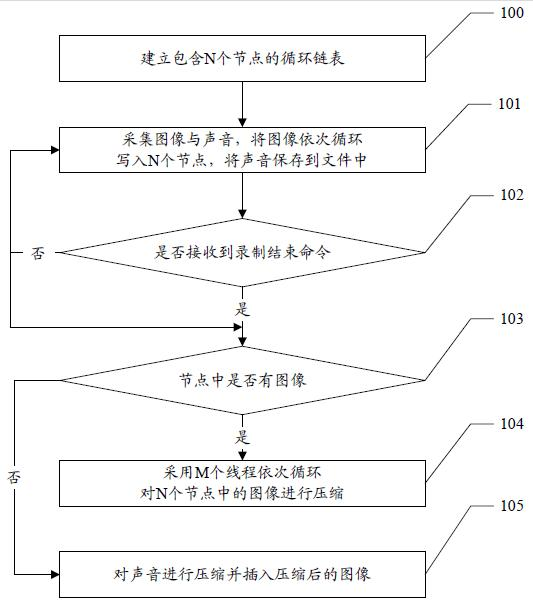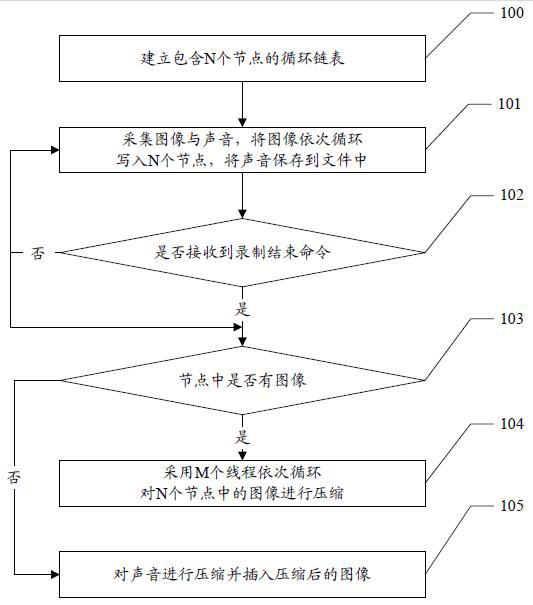Screen recording method and device
A screen and node technology, applied in the field of screen recording methods and devices, can solve problems such as increased CPU usage, conflicts in reading and writing files, and slow compression speed, so as to reduce the occupation rate, reduce conflicts in reading and writing files, and improve compression The effect of speed
- Summary
- Abstract
- Description
- Claims
- Application Information
AI Technical Summary
Problems solved by technology
Method used
Image
Examples
Embodiment 1
[0039] The screen recording method of the present invention includes:
[0040] Step 101: Collect images and sounds, save the collected sounds in a sound file, and write the collected images into the memory;
[0041] Step 102: Determine whether the recording end command is received, if it is received, go to step 103, if not, go back to step 101, and go to step 103 at the same time;
[0042] Step 103: Determine whether there is an image in the memory, go to step 104 if there is an image, and go to step 105 if there is no image;
[0043] Step 104: Use M threads to compress the image in the memory, and save the compressed image in an image file;
[0044] Step 105: Compress the sound in the sound file, and insert the compressed sound into the compressed image to form a video file.
[0045] Step 101 of this embodiment obtains the current image of the screen by taking a screenshot, obtains the current sound from the microphone, and saves the image and sound separately. Because the image occupi...
Embodiment 2
[0048] The first embodiment saves the image to the memory, and changes the address every time it is written, such as figure 1 As shown, in order to simplify the read and write operations, this embodiment creates a circular linked list in the memory, and the entire collection process only involves a limited number of addresses. The details are as follows.
[0049] Step 100 is also included before step 101:
[0050] Step 100: Establish a circular linked list containing N nodes in the memory.
[0051] So far, the memory involved in the subsequent steps is represented by N nodes in the above circular linked list, and the size of each node is the size of one frame of image. Step 101: Write each frame of image collected into N nodes of the circular linked list in turn, and each node writes one frame. When the Nth node is written, it transfers to the first node to continue writing, and so on. At the same time, step 104 is also compressing the image. For each node, before the next write, th...
Embodiment 3
[0055] In this embodiment, a flag bit is added to each node to avoid errors caused by inconsistency between the collection speed and the compression speed, as follows.
[0056] While establishing a circular linked list of N nodes in step 100, configure a flag bit for each node, and set the initial flag of the flag bit as read, which means that the node has not yet been stored in the image or the image has been read go.
[0057] In the second embodiment, step 101 writes the collected images of each frame sequentially to the N nodes of the circular linked list. The specific implementation method is to determine whether the flag bit of the node to be written is read, if otherwise, wait until the node's The flag bit becomes read. If it is, write the collected image to the node and the node's flag position is written. This step is repeated for N nodes in turn. The written meaning means that the node has stored the image.
[0058] The specific implementation of step 103 in the second embo...
PUM
 Login to View More
Login to View More Abstract
Description
Claims
Application Information
 Login to View More
Login to View More - R&D
- Intellectual Property
- Life Sciences
- Materials
- Tech Scout
- Unparalleled Data Quality
- Higher Quality Content
- 60% Fewer Hallucinations
Browse by: Latest US Patents, China's latest patents, Technical Efficacy Thesaurus, Application Domain, Technology Topic, Popular Technical Reports.
© 2025 PatSnap. All rights reserved.Legal|Privacy policy|Modern Slavery Act Transparency Statement|Sitemap|About US| Contact US: help@patsnap.com



